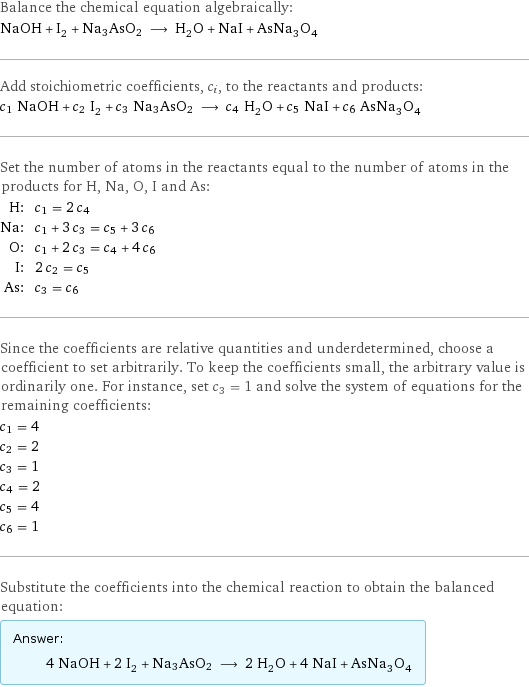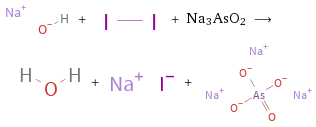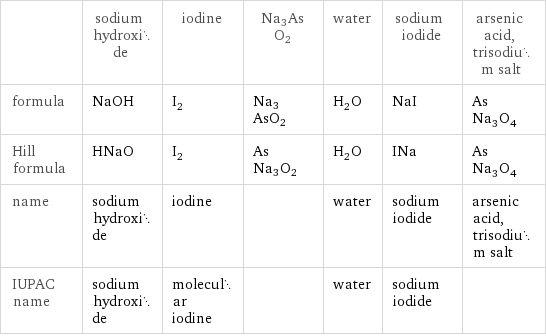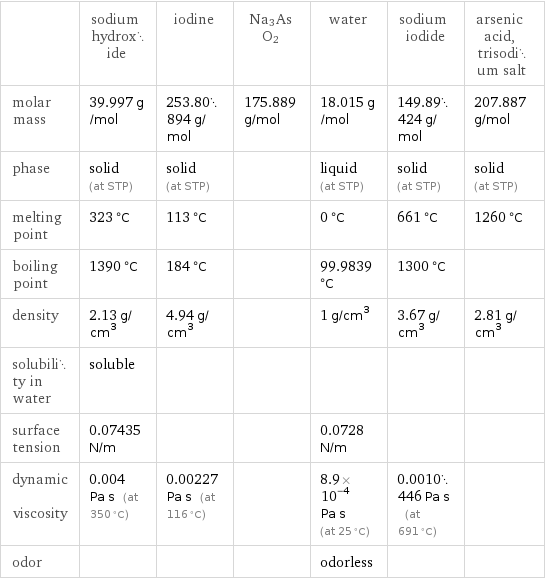Input interpretation

NaOH sodium hydroxide + I_2 iodine + Na3AsO2 ⟶ H_2O water + NaI sodium iodide + AsNa_3O_4 arsenic acid, trisodium salt
Balanced equation

Balance the chemical equation algebraically: NaOH + I_2 + Na3AsO2 ⟶ H_2O + NaI + AsNa_3O_4 Add stoichiometric coefficients, c_i, to the reactants and products: c_1 NaOH + c_2 I_2 + c_3 Na3AsO2 ⟶ c_4 H_2O + c_5 NaI + c_6 AsNa_3O_4 Set the number of atoms in the reactants equal to the number of atoms in the products for H, Na, O, I and As: H: | c_1 = 2 c_4 Na: | c_1 + 3 c_3 = c_5 + 3 c_6 O: | c_1 + 2 c_3 = c_4 + 4 c_6 I: | 2 c_2 = c_5 As: | c_3 = c_6 Since the coefficients are relative quantities and underdetermined, choose a coefficient to set arbitrarily. To keep the coefficients small, the arbitrary value is ordinarily one. For instance, set c_3 = 1 and solve the system of equations for the remaining coefficients: c_1 = 4 c_2 = 2 c_3 = 1 c_4 = 2 c_5 = 4 c_6 = 1 Substitute the coefficients into the chemical reaction to obtain the balanced equation: Answer: | | 4 NaOH + 2 I_2 + Na3AsO2 ⟶ 2 H_2O + 4 NaI + AsNa_3O_4
Structures

+ + Na3AsO2 ⟶ + +
Names

sodium hydroxide + iodine + Na3AsO2 ⟶ water + sodium iodide + arsenic acid, trisodium salt
Equilibrium constant
![Construct the equilibrium constant, K, expression for: NaOH + I_2 + Na3AsO2 ⟶ H_2O + NaI + AsNa_3O_4 Plan: • Balance the chemical equation. • Determine the stoichiometric numbers. • Assemble the activity expression for each chemical species. • Use the activity expressions to build the equilibrium constant expression. Write the balanced chemical equation: 4 NaOH + 2 I_2 + Na3AsO2 ⟶ 2 H_2O + 4 NaI + AsNa_3O_4 Assign stoichiometric numbers, ν_i, using the stoichiometric coefficients, c_i, from the balanced chemical equation in the following manner: ν_i = -c_i for reactants and ν_i = c_i for products: chemical species | c_i | ν_i NaOH | 4 | -4 I_2 | 2 | -2 Na3AsO2 | 1 | -1 H_2O | 2 | 2 NaI | 4 | 4 AsNa_3O_4 | 1 | 1 Assemble the activity expressions accounting for the state of matter and ν_i: chemical species | c_i | ν_i | activity expression NaOH | 4 | -4 | ([NaOH])^(-4) I_2 | 2 | -2 | ([I2])^(-2) Na3AsO2 | 1 | -1 | ([Na3AsO2])^(-1) H_2O | 2 | 2 | ([H2O])^2 NaI | 4 | 4 | ([NaI])^4 AsNa_3O_4 | 1 | 1 | [AsNa3O4] The equilibrium constant symbol in the concentration basis is: K_c Mulitply the activity expressions to arrive at the K_c expression: Answer: | | K_c = ([NaOH])^(-4) ([I2])^(-2) ([Na3AsO2])^(-1) ([H2O])^2 ([NaI])^4 [AsNa3O4] = (([H2O])^2 ([NaI])^4 [AsNa3O4])/(([NaOH])^4 ([I2])^2 [Na3AsO2])](../image_source/2d3b6e63dfe0ee00ea32f949321f1d30.png)
Construct the equilibrium constant, K, expression for: NaOH + I_2 + Na3AsO2 ⟶ H_2O + NaI + AsNa_3O_4 Plan: • Balance the chemical equation. • Determine the stoichiometric numbers. • Assemble the activity expression for each chemical species. • Use the activity expressions to build the equilibrium constant expression. Write the balanced chemical equation: 4 NaOH + 2 I_2 + Na3AsO2 ⟶ 2 H_2O + 4 NaI + AsNa_3O_4 Assign stoichiometric numbers, ν_i, using the stoichiometric coefficients, c_i, from the balanced chemical equation in the following manner: ν_i = -c_i for reactants and ν_i = c_i for products: chemical species | c_i | ν_i NaOH | 4 | -4 I_2 | 2 | -2 Na3AsO2 | 1 | -1 H_2O | 2 | 2 NaI | 4 | 4 AsNa_3O_4 | 1 | 1 Assemble the activity expressions accounting for the state of matter and ν_i: chemical species | c_i | ν_i | activity expression NaOH | 4 | -4 | ([NaOH])^(-4) I_2 | 2 | -2 | ([I2])^(-2) Na3AsO2 | 1 | -1 | ([Na3AsO2])^(-1) H_2O | 2 | 2 | ([H2O])^2 NaI | 4 | 4 | ([NaI])^4 AsNa_3O_4 | 1 | 1 | [AsNa3O4] The equilibrium constant symbol in the concentration basis is: K_c Mulitply the activity expressions to arrive at the K_c expression: Answer: | | K_c = ([NaOH])^(-4) ([I2])^(-2) ([Na3AsO2])^(-1) ([H2O])^2 ([NaI])^4 [AsNa3O4] = (([H2O])^2 ([NaI])^4 [AsNa3O4])/(([NaOH])^4 ([I2])^2 [Na3AsO2])
Rate of reaction
![Construct the rate of reaction expression for: NaOH + I_2 + Na3AsO2 ⟶ H_2O + NaI + AsNa_3O_4 Plan: • Balance the chemical equation. • Determine the stoichiometric numbers. • Assemble the rate term for each chemical species. • Write the rate of reaction expression. Write the balanced chemical equation: 4 NaOH + 2 I_2 + Na3AsO2 ⟶ 2 H_2O + 4 NaI + AsNa_3O_4 Assign stoichiometric numbers, ν_i, using the stoichiometric coefficients, c_i, from the balanced chemical equation in the following manner: ν_i = -c_i for reactants and ν_i = c_i for products: chemical species | c_i | ν_i NaOH | 4 | -4 I_2 | 2 | -2 Na3AsO2 | 1 | -1 H_2O | 2 | 2 NaI | 4 | 4 AsNa_3O_4 | 1 | 1 The rate term for each chemical species, B_i, is 1/ν_i(Δ[B_i])/(Δt) where [B_i] is the amount concentration and t is time: chemical species | c_i | ν_i | rate term NaOH | 4 | -4 | -1/4 (Δ[NaOH])/(Δt) I_2 | 2 | -2 | -1/2 (Δ[I2])/(Δt) Na3AsO2 | 1 | -1 | -(Δ[Na3AsO2])/(Δt) H_2O | 2 | 2 | 1/2 (Δ[H2O])/(Δt) NaI | 4 | 4 | 1/4 (Δ[NaI])/(Δt) AsNa_3O_4 | 1 | 1 | (Δ[AsNa3O4])/(Δt) (for infinitesimal rate of change, replace Δ with d) Set the rate terms equal to each other to arrive at the rate expression: Answer: | | rate = -1/4 (Δ[NaOH])/(Δt) = -1/2 (Δ[I2])/(Δt) = -(Δ[Na3AsO2])/(Δt) = 1/2 (Δ[H2O])/(Δt) = 1/4 (Δ[NaI])/(Δt) = (Δ[AsNa3O4])/(Δt) (assuming constant volume and no accumulation of intermediates or side products)](../image_source/4e7ba20a71deb5c92b3f515cffd634a9.png)
Construct the rate of reaction expression for: NaOH + I_2 + Na3AsO2 ⟶ H_2O + NaI + AsNa_3O_4 Plan: • Balance the chemical equation. • Determine the stoichiometric numbers. • Assemble the rate term for each chemical species. • Write the rate of reaction expression. Write the balanced chemical equation: 4 NaOH + 2 I_2 + Na3AsO2 ⟶ 2 H_2O + 4 NaI + AsNa_3O_4 Assign stoichiometric numbers, ν_i, using the stoichiometric coefficients, c_i, from the balanced chemical equation in the following manner: ν_i = -c_i for reactants and ν_i = c_i for products: chemical species | c_i | ν_i NaOH | 4 | -4 I_2 | 2 | -2 Na3AsO2 | 1 | -1 H_2O | 2 | 2 NaI | 4 | 4 AsNa_3O_4 | 1 | 1 The rate term for each chemical species, B_i, is 1/ν_i(Δ[B_i])/(Δt) where [B_i] is the amount concentration and t is time: chemical species | c_i | ν_i | rate term NaOH | 4 | -4 | -1/4 (Δ[NaOH])/(Δt) I_2 | 2 | -2 | -1/2 (Δ[I2])/(Δt) Na3AsO2 | 1 | -1 | -(Δ[Na3AsO2])/(Δt) H_2O | 2 | 2 | 1/2 (Δ[H2O])/(Δt) NaI | 4 | 4 | 1/4 (Δ[NaI])/(Δt) AsNa_3O_4 | 1 | 1 | (Δ[AsNa3O4])/(Δt) (for infinitesimal rate of change, replace Δ with d) Set the rate terms equal to each other to arrive at the rate expression: Answer: | | rate = -1/4 (Δ[NaOH])/(Δt) = -1/2 (Δ[I2])/(Δt) = -(Δ[Na3AsO2])/(Δt) = 1/2 (Δ[H2O])/(Δt) = 1/4 (Δ[NaI])/(Δt) = (Δ[AsNa3O4])/(Δt) (assuming constant volume and no accumulation of intermediates or side products)
Chemical names and formulas

| sodium hydroxide | iodine | Na3AsO2 | water | sodium iodide | arsenic acid, trisodium salt formula | NaOH | I_2 | Na3AsO2 | H_2O | NaI | AsNa_3O_4 Hill formula | HNaO | I_2 | AsNa3O2 | H_2O | INa | AsNa_3O_4 name | sodium hydroxide | iodine | | water | sodium iodide | arsenic acid, trisodium salt IUPAC name | sodium hydroxide | molecular iodine | | water | sodium iodide |
Substance properties

| sodium hydroxide | iodine | Na3AsO2 | water | sodium iodide | arsenic acid, trisodium salt molar mass | 39.997 g/mol | 253.80894 g/mol | 175.889 g/mol | 18.015 g/mol | 149.89424 g/mol | 207.887 g/mol phase | solid (at STP) | solid (at STP) | | liquid (at STP) | solid (at STP) | solid (at STP) melting point | 323 °C | 113 °C | | 0 °C | 661 °C | 1260 °C boiling point | 1390 °C | 184 °C | | 99.9839 °C | 1300 °C | density | 2.13 g/cm^3 | 4.94 g/cm^3 | | 1 g/cm^3 | 3.67 g/cm^3 | 2.81 g/cm^3 solubility in water | soluble | | | | | surface tension | 0.07435 N/m | | | 0.0728 N/m | | dynamic viscosity | 0.004 Pa s (at 350 °C) | 0.00227 Pa s (at 116 °C) | | 8.9×10^-4 Pa s (at 25 °C) | 0.0010446 Pa s (at 691 °C) | odor | | | | odorless | |
Units
